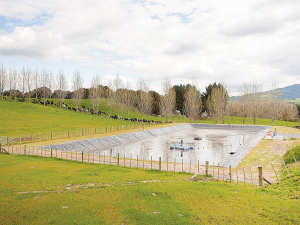Dairy farmers welcome NZ’s revised 2050 methane target
The Government's revised 2050 biogenic methane target range of 14-24% by 2050 is being welcomed by dairy farmers.
 Good effluent management is having a well-designed system and processes to apply the right amount at the right time.
Good effluent management is having a well-designed system and processes to apply the right amount at the right time.
Good effluent management on a dairy farm combines a well-designed system with proper processes to ensure the right amount of effluent gets applied to pasture at the right time.
This not only saves on fertiliser costs and enhances soil health but also helps prevent animal health problems and ensures compliance with local rules. Understanding soil water deficit is crucial to prevent run-off and applying effluent to saturated soils.
There are tools available, such as the DairyNZ Farm Dairy Effluent Spreading Calculator, to help manage the application of effluent nutrients with precision. Finally, regular maintenance of your irrigation application equipment is vital for optimal performance.
Good effluent management is a combination of having a well-designed effluent system and processes for people that make sure the effluent the system collects is applied to pasture in the right amount at the right time.
On-farm benefits of good effluent management include:
Making good effluent irrigation decisions
The key to good decision making is understanding the soil water deficit. It is essential to prevent ponding and runoff and to avoid applying effluent to saturated soils.
Soil water deficit is the amount of water (i.e. effluent) which can be applied to the soil before it reaches field capacity (which refers to the amount of water held in the soil after excess water has drained away). If effluent is added at field capacity it will likely result in ponding, runoff or leaching.
Effluent spreading
New Zealand’s dairy farm systems produce large quantities of nutrient- rich effluent which are captured from milking sheds, holding yards, feed pads, standoff pads, and animal shelters. The average dairy cow produces about $25 worth of nutrients annually as farm dairy effluent (FDE). For a 400-cow dairy herd this represents about $10,000 of nutrients annually. Using effluent to supplement fertiliser presents an opportunity to capitalise on a cost-effective nutrient resource while improving whole farm nutrient use efficiency.
Effluent is commonly grouped into three broad categories based on dry matter (DM) content: liquids (0–5%), slurries (5–15%) and solids (>15%).
Application of effluents is typically via land.
Effluent application to pasture
To get good value out of effluent and reduce environmental risk consider:
Where possible, leave a buffer strip next to waterways and farm boundaries and know your consent conditions and/or regional rules.
Article - DairyNZ
Acclaimed fruit grower Dean Astill never imagined he would have achieved so much in the years since being named the first Young Horticulturist of the Year, 20 years ago.
The Ashburton-based Carrfields Group continues to show commitment to future growth and in the agricultural sector with its latest investment, the recently acquired 'Spring Farm' adjacent to State Highway 1, Winslow, just south of Ashburton.
New Zealand First leader and Foreign Affairs Minister Winston Peters has blasted Fonterra farmers shareholders for approving the sale of iconic brands to a French company.
A major feature of the Ashburton A&P Show, to be held on October 31 and November 1, will be the annual trans-Tasman Sheep Dog Trial test match, with the best heading dogs from both sides of the Tasman going head-to-head in two teams of four.
Fewer bobby calves are heading to the works this season, as more dairy farmers recognise the value of rearing calves for beef.
The key to a dairy system that generates high profit with a low emissions intensity is using low footprint feed, says Fonterra program manager on-farm excellence, Louise Cook.